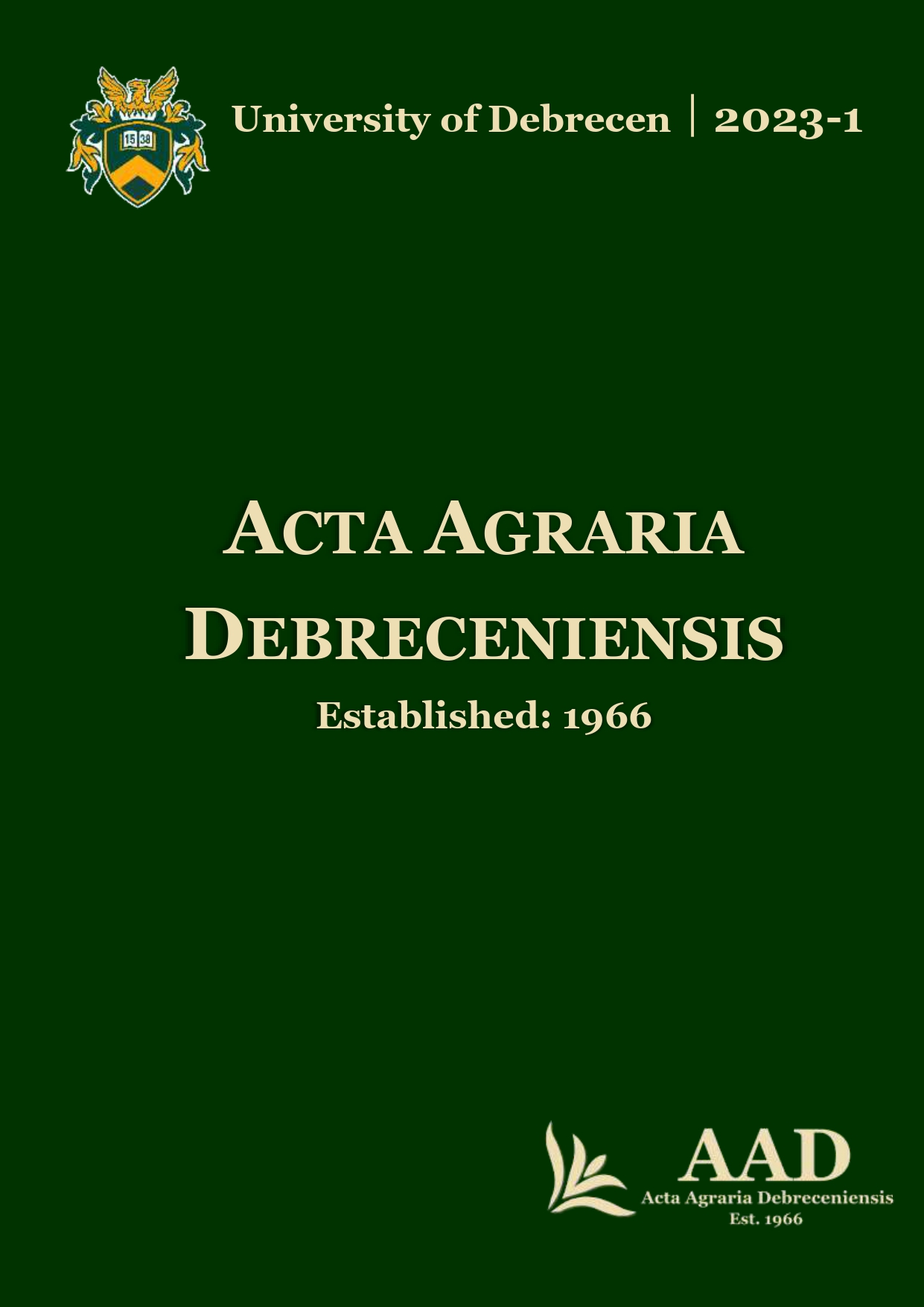Examination of the decomposition of willow (Salix sp.), poplar (Populus sp.), reed (Phragmites australis) and mixed leaf litter with litterbag technique
Authors
View
Keywords
License
Copyright (c) 2023 by the Author(s)

This work is licensed under a Creative Commons Attribution 4.0 International License.
How To Cite
Accepted 2023-04-17
Published 2023-06-05
Abstract
Leaf litter decomposition is one of the main ecological material cycle processes in waterfront areas. In this microcosm experiment, the rate of decomposition of the most frequently occurring dominant waterside plants were examined in the summer months of 2022 in a class “A” evaporation pan, using litterbag technique. The study provides information about the decomposition dynamics of willow (Salix sp.), poplar (Populus sp.), reed (Phragmites australis) and different leaf litter mixture combinations. Dry mass, exponential decay coefficient and the chemical parameters of the water (pH, conductivity, NH4+, PO43-, SO42-) were determined during the 84 days long experimental period. The weight loss curves showed negative exponential pattern in every case. On average, the different samples lost ~ 57% of their initial dry mass during the experimental period. The largest mass loss was measured in case of poplar (67.2%), while reed leaves had the smallest mass loss (47.25%). Based on the results, it cannot be proven, that mixed leaf litter accelerates the rate of decomposition.
References
- Asaeda, T.–Nam, L.H. (2002): Effects of rhizome age on the decomposition rate of Phragmites australis rhizomes. Hydrobiologia. 485: 205–208. DOI: https://doi.org/10.1023/A:1021314203532
- Ágoston-Szabó, E.–Dinka, M. (2008): Decomposition of Typha angustifolia and Phragmites australis in the littoral zone of a shallow lake. Biologia. 63: 1104–1110. DOI: https://doi.org/10.2478/s11756-008-0154-4
- Ágoston-Szabó, E.–Schöll, K.–Kiss, A.–Dinka, M. (2016): Mesh size and site effects on leaf litter decomposition in a side arm of the River Danube on the Gemenc floodplain (Danube-Dráva National Park, Hungary). Hydrobiologia. 774: 53–68. DOI: https://doi.org/10.1007/s10750-015-2616-3
- Bagi, I.–Bartha, D.–Bartha S.–Borhidi, A. (1996): A magyarországi élőhelyek leírása és határozókönyve – A nemzeti élőhely osztályozási rendszer. Természettudományi Múzeum, Budapest. 147–148.
- Bärlocher, F. (2005): Leaf Mass Loss Estimated by Litter Bag Technique. In: Graça M.A.S.–Bärlocher F.–Gessner M.O. Eds., Methods to Study Litter Decomposition, a Practical Guide, Springer, Dordrecht, 37–42. DOI: https://doi.org/10.1007/1-4020-3466-0_6
- Bärlocher, F.–Kendrick, B. (1981): Role of aquatic hyphomycetes in the trophic structure of streams. The fungal community: its organization and role in the ecosystem. Marcel Dekker, New York.
- Chapman, S.K.–Koch, G.W. (2007): What type of diversity yields synergy during mixed litter decomposition in a natural forest ecosystem? Plant Soil, 299: 153. DOI: https://doi.org/10.1007/s11104-007-9372-8
- Chen, Y.–Ma, S.–Jiang, H.–Yangzom, D.–Cheng, G.–Lu, X. (2019): Decomposition time, chemical traits and climatic factors determine litter-mixing effects of decomposition in an alpine steppe ecosystem in Northern Tibet. Plant Soil. 459: 23–35. DOI: https://doi.org/10.1007/s11104-019-04131-9
- Dobson, M.–Frid, C. (1998): Ecology of Aquatic Systems Longman, Essex.
- Garbowsky, T. (2019): Changes in the Physico-Chemical Parameters of Water as a Result of Long-Term Contact with Biomass, on the Example of Pine Bark (Pinus sylvestris). Water, Air, & Soil Pollution, 230: 104. DOI: https://doi.org/10.1007/s11270-019-4160-7
- Gombos, B. (2011): Hidrológia, hidraulika. Szent István Egyetem.
- Harmon, M.E.–Nadelhoffer, K.J.–Blair, J.M. (1999): Measuring decomposition, nutrient turnover and stores in plant litter. In: Robertson, G.P.–Bledsoe, C.S.–Coleman, D.S.–Sollins, P., Eds., Standard soil methods for long-term ecological research. Oxford University Press, New York, 222–240.
- Hasanuzzaman, M.D.–Hossain, M. (2014): Nutrient Leaching from Leaf Litter of Cropland Agroforest Tree Species of Bangladesh. Journal of Forest and Environmental Science, 30: 208–217. DOI: https://doi.org/10.7747/JFS.2014.30.2.208
- Hubai, K.E.–Padisák, J. (2017): Az avarlebontás folyamatainak karakterisztikái dunántúli kisvízfolyásokban. Kémiai és Környezettudományi Doktori Iskola, Veszprém.
- Jenny, H.–Gessel, S.P.–Bingham, F.T. (1949): Comparative study of decomposition rates of organic matter in temperate and tropical regions. Soil Science, 68: 419–432. DOI: 10.1097/00010694-194912000-00001
- Jespersen, J.M.–Becker, L.–Hix, K.–Greedy, C.K. (2016): The effects of urbanization on leaf breakdown rates in a rock island watershed. Environmental Science.
- Kadlec, R.H.–Wallace, S.D. (2019): Treatment wetlands (2nd ed.). Boca Raton: CRC Press. 1016.
- Lecerf, A.–Marie, G.–Kominoski, J.S.–LeRoy, C.J.–Bernadet, C.–Swan, C.M. (2011): Incubation time, functional litter diversity, and habitat characteristics predict litter-mixing effects on decomposition. Ecology. 92: 160–169. DOI: https://doi.org/10.1890/10-0315.1
- Migliorini, G.H.–Romeo, G.Q. (2020): Warming and leaf litter functional diversity, not litter quality, drive decomposition in a freshwater ecosystem. Sci. Rep., 10: 20333. DOI: https://doi.org/10.1038/s41598-020-77382-7
- Petersen, R.C.–Cummins, K.W. (1974): Leaf processing in a woodland stream. Freshwater Biology, 4: 343–368. DOI: https://doi.org/10.1111/j.1365-2427.1974.tb00103.x
- Simon, B.–Kucserka, T.–Anda, A. (2019): Investigation of the decomposition and leaching dynamics of Salix, Populus and mixed leaves in the area of Lake Balaton and Kis-Balaton Wetland. Acta Agraria Debreceniensis, 1: 119–124. DOI: https://doi.org/10.34101/actaagrar/1/2382
- Simon, Sz.–Simon, B.–Anda, A. (2021): Examination of nutrient leaching dynamics of Solidago virgaurea in Hévíz Lake and Hévíz canal. Acta Agraria Debreceniensis, 1: 207–211. DOI: http://dx.doi.org/10.34101/actaagrar/1/8357
- Wrubleski, D.A.–Murkin, H.R.–van der Valk, A.G.–Nelson. J.W. (1997): Decomposition of emergent macrophyte roots and rhizomes in a northern prairie marsh. Aquatic Botany. 58: 121–134. DOI: https://doi.org/10.1016/S0304-3770(97)00016-8

 https://doi.org/10.34101/actaagrar/1/12089
https://doi.org/10.34101/actaagrar/1/12089